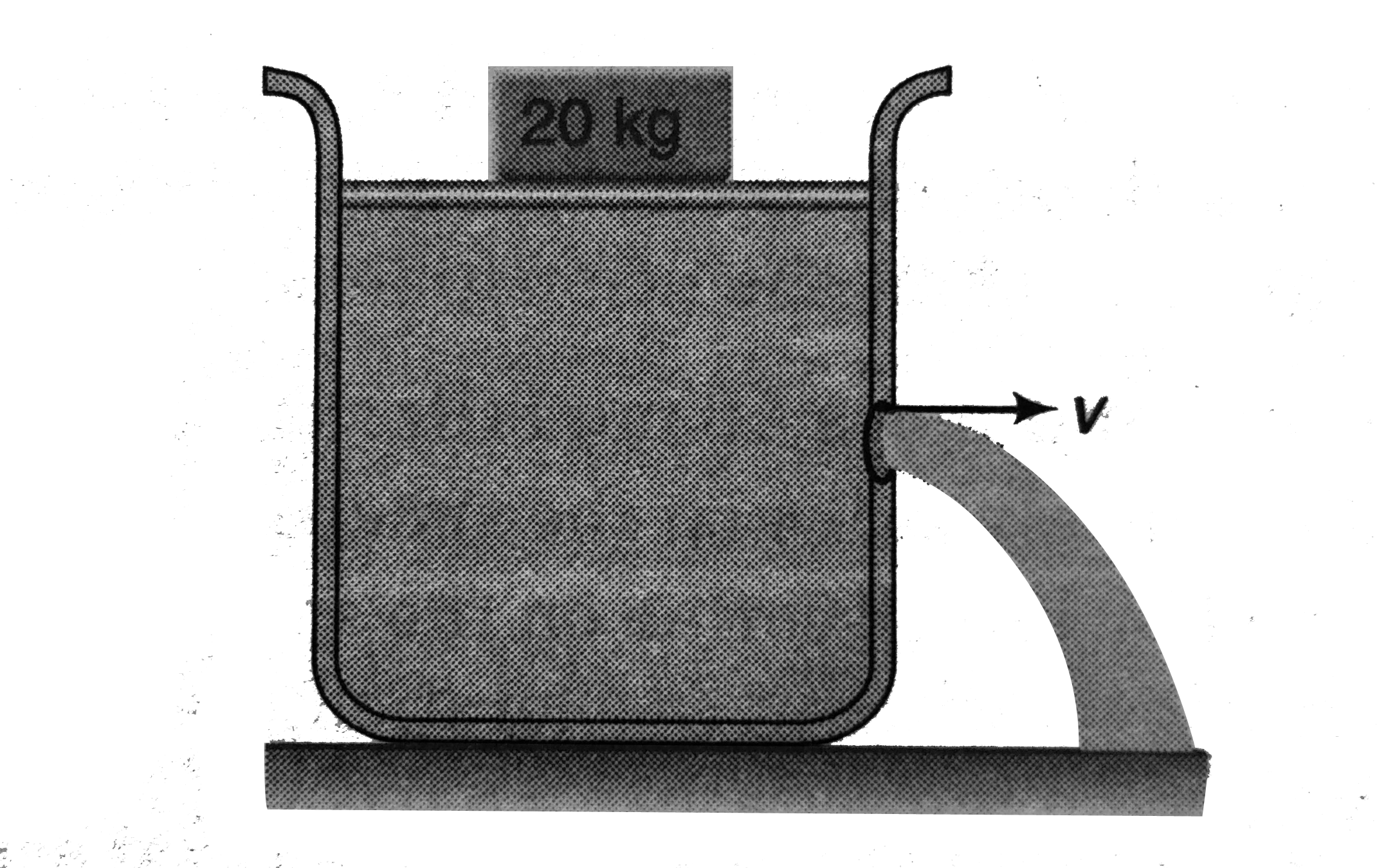A long cylindrical tank of cross-sectional area 0.5m2 is filled with water. It has a small hole at a height 50cm from the bottom. A movable piston of cross-sectional area almost equal to 0.5m2 is fitted on the top of the tank such that it can slide in the tank freely. A load of 20kg is applied on the top of the water by piston, as shown in the figure. Calculate the speed of the water jet with which it hits the surface when piston is 1m above the bottom. (Ignore the mass of the piston)

With respect to the opening the height of the piston is 0.5m.
Pressure at the top is P1=P0+20×10N0.5m2
where P0 is the atmospheric pressure.
Pressure at the opeing is P2=P0, From Bernoulli's equation,
we have
P1+ρgh+12ρv21=P2+12ρv22
On solving, we get v2=3.3m/s=vx(say)
vy=√2gh
v=√v2x+v2y=4.56m/s

Topper's Solved these Questions
Similar Questions
A long cylindrical tank of cross-section area 0.5m2 is filled with water. It has an opening at a height 50 cm from the bottom, having area of cross-section 1×10−4m2. A movable piston of cross-section area almost equal to 0.5m2 is fitted on the top of the tank such that it can slide in the tank freely. A load of 20 kg is applied on the top of the water by piston, as shown in the figure. Find the speed of the water jet with which it hits the surface when piston is 1m above the bottom. (Ignore the mass of the piston). If this speed is (18x) m/s, find the value of x.
 View Solution
View Solution_S01_053_Q01.png)
A large cylinderical tank of cross-sectional area 1m2 is filled with water . It has a small hole at a height of 1 m from the bottom. A movable piston of mass 5 kg is fitted on the top of the tank such that it can slide in the tank freely. A load of 45 kg is applied on the top of water by piston, as shown in figure. The value of v when piston is 7 m above the bottom is (g=10m/s2)
(a). √120m/s
(b). 10m/s
(c). 1m/s
(d). 11m/sView Solution
Knowledge Check
- Question 1 - Select One
A cylindrical tank having cross-sectional area A is filled with water to a height of 2.0 m. A circular hole of corss-section area is opened at a height of 75 cm from the bottom. If a/A=√0.2, then velocity with which waer emerges from the hole is
(g=9.8ms−2)A4.9ms−1B4.95ms−1C5.0ms−1D5.5ms−1 - Question 2 - Select One
The inductance of a solenoid 0.5m long of cross-sectional area 20cm2 and with 500 turns is
A12.5mHB1.25mHC15.0mHD0.12mH - Question 3 - Select One
A cyclinderical vessel of cross-sectional area 1000cm2, fitted with a frictonless piston of mass 10kg, and filled with water completely. A small hole of cross-sectional area 10mm2 is opened at a point 50cm deep from the lower surface of the piston. The velocity of efflux from the hole will be
A10.5m/sB3.4m/sC0.8m/sD0.2m/s
A cylindrical tank of cross sectional area a1 is filled with water to a height h. A hole of cross sectional area a2 is made at the bottom. If a1=5a2, then find the
(i) initial velocity with which the water falls in tank.
(ii) initial velocity with which water emerges out from hole.
(iii) time taken to make the tank empty.View SolutionA cylinderical jar of cross-sectional area of 50cm2 is filled with water to a height of 20cm. It carries a tight fitting piston of negligible mass. Calculate the pressure at the bottom of the jar when a mass of 1kg is placed on the piston . Ignore atmospheric pressure.
View SolutionA area of cross section of a large tank is 0.5m2. It has an opening near the bottom having area of cross section 1cm2. A load of 20 kg is applied on the water at the top. Find the velocity of the water coming out of the opening at the time when the height of water level is 50 cm above the bottom. Take g=10ms−2
View SolutionA cylindrical tank is filled with water to a level of 4 m. A hole is opened at a height of 60 cm from bottom. The ratio of the area of the hole to that at cross-sectinal area at cylinder is 0.2. Then the velocity with which water is coming out is (g=10m/s2)
View SolutionA cylindrical tank is filled with water to a level of 3m. A hole is opened at a height of 52.5 cm from bottom. The ratio of the area of the hole to that of cross-sectional area of the cylinder is 0.1. The square of the speed with which water is coming out from the orifice is (Take g=10m/s2)
View Solution

